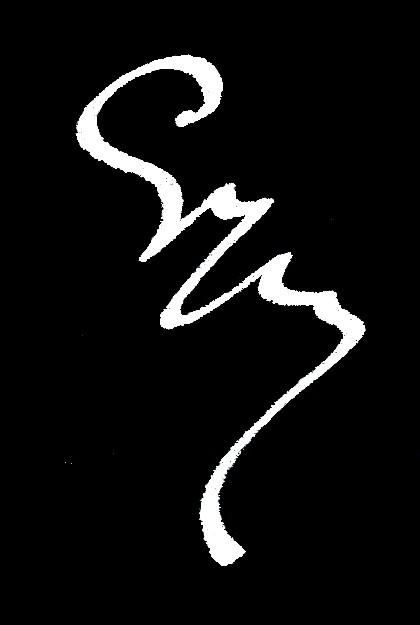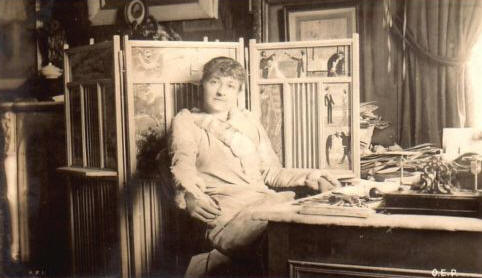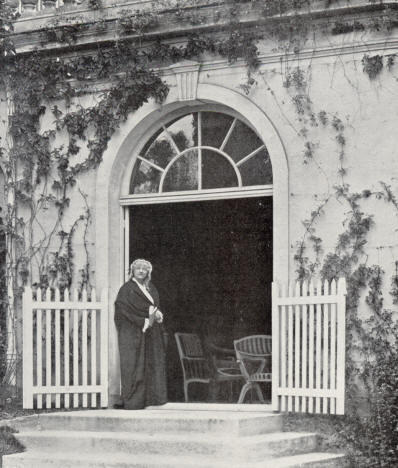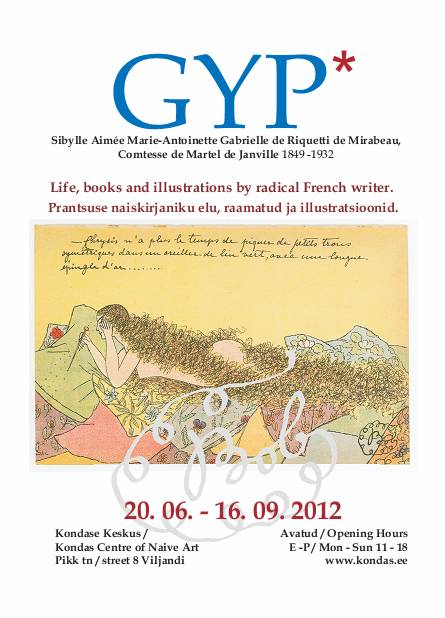|
gyp
|
Under Construction
Sibylle Aimée Marie-Antoinette Gabrielle de Riquetti de Mirabeau, Comtesse de Martel de Janville *
* Gyp Paris 1849 - 1932
|
|||||
|
|
GYP was a, creative, opinionated, innovative, radical writer, novelist, artist, political-activist woman of aristocracy in turn-of-the-century Paris. Her formal name was Sibylle Aimée Marie-Antoinette Gabrielle de Riquetti de Mirabeau, Comtesse de Martel de Janville. She was a countess by inheritance, a descendant of the great statesman of the French Revolution, Honorè Gabriel Riquetti Mirabeau. She was also a countess by marriage when in 1867 she married Count Roger de Martel de Janville. Gabrielle, as she was known to her family and friends, grew up to be an aristocrat, a countess with obligations. She should have been happy with and entirely devoted to her social duties, but she discovered early that she could not live comfortably in her aristocratic role. She began writing. But it was not acceptable for her to write as either an aristocrat or a woman, so she assumed a nom de plume. “Gyp” became her writer persona, and when she began to illustrate her work, she assumed an artist persona as well. It was ”Bob.” Petit Bob was the precocious 8 year old lad, a character in her early novels. who served-up her most satirical and biting dishes. Her pseudonyms allowed her to write and paint with minimal problems. The world she was born into was an admixture of enlightenment and corruption. France was growing her modern legs – music, theatre, art and social life was sophisticated and exciting - it was the belle epoque - but politics and business struggled with old paradigms. Gyp loved and hated both and found herself living in both worlds. Her penchant – what she addressed most in her writing and paintings – was the disfunctionality and hypocrisy of society, politics, business and the ideologies that engined them.. She disliked her own aristocracy, but hated the bumbling bourgeois with equal passion. She targeted politicians, censors, Jewish bankers, the press, changing mores, electricity and corsets. Little was out-of-bounds for her quill pen or brush. She often couched the players in her novels in childlike stories and dialogs. Her colorful painted caricatures were pointed. Gyp was direct, plain and simple. She had strong opinions and was not afraid to express them. People liked what she wrote and painted, so she was able to keep doing it. Gyp claimed that ”writing bores me to tears,” yet she wrote every night and produced more than 2 ½ novels a year for 50 years! But she had to work. Roger, her husband, insisted that as a count he shouldn’t work for a living; his inheritance should support him and his family. But it didn’t. After Gabrielle and Roger had three children and had moved to Neuilly-sur-Seine on the outskirts of Paris, they had to sell their inherited homes to live in the modern world. Gyp once said that she could either write or join the circus, but she had to work because her husband didn’t. For fifty
years, from 1879 on, Gyp and her family lived in Neuilly-on-the-Seine.
Neuilly was an enclave for writers, artists and thinkers. On Sundays,
for most of those years, Gyp invited guests to her home for lunch at
noon and an evening dinner. Her “salon” was frequented by the likes of
Antole France, Edward Degas, Marcel Proust, Paul Valéry, François Coppée
or Henri Becque. She hosted the event in unconventional dress, lounged
in her favorite overstuffed chair, and talked constantly, telling
stories of the theatre, art, politics or general clubhouse gossip. Roger
usually spent the day in the back garden for shooting practice. Gyp wrote through the night, every night. And virtually everything she wrote got published, mostly because people could relate to her work, and it sold. Publishers competed for her books, even though they were often controversial, because they made them a lot of money. Most were romance novels; and the same characters appeared often. Autour du Mariage, (1883, 90 printings), Autour du Divorce (1886, 48 printings) and Le Mariage de Chiffon (1894, 134 printings) explored the tribulations of Paulette, a 20 year old typical, modern Parisian girl and her love-adventures. Petit Bob (1882), Bob à l’Exposition (1889) and Bob au Salon (1889) follow the exploits of Petit Bob the mischief-maker. The series of three books illustrated by Bob, Ohé! Les Dirigeants! (Hey! The Leaders) (1896), En Balade, (Out for a Stroll) (1897), and Les Gens Chics, (The Chic People) (1895) all look at the hypocrisy and decadence of Paris through the questioning mind and eyes of Bob, the intelligent and curious boy of eight. Bob draws and paints pictures of the world he encounters in his journeys and imaginings. His visualizations are confrontational, questioning, bold and sometimes rude, as rude as an eight-year-old can be. Bob, of course, is Gyp, the writer and illustrator. Gyp wrote and published 134 books in her lifetime. Gyp, like most Parisians, especially artists and writers, was caught up in the issues of the day. The Dreyfus Affair (Alfred Dreyfus, a Jewish military officer accused and ultimately acquitted of treason) engaged her for a time. She saw it as an example of political corruption. Gyp was an anti-Dreyfusard, and some of her Le Rire illustrations were about Dreyfus, the pro-Dreyfusards, and by extension, others already on her list as part of the political and financial corruption she disliked so vehemently. She developed a characteristic “look” for her illustrations of Jews, and coupled with her often radical rhetoric, was labeled as part of an anti-Semite faction. This socio-political noise eventually faded from the news, and of course, from Gyp’s repertoire as well. The three
books featured in this exhibit and her pages in Le Rire, the French
humor magazine also in this exhibit, are painted under the nom de
plume of “Bob” and signed with her characteristic script, “Bob”
surrounded with curley-ques. The bold colors, simple naïve style and
unusual subjects make her work quite unique. Historically her artistic
genius is part of the genre of the caricaturists and poster artists of
the period: Le Rire (A Laugh) was founded in 1894 by Felix Juven, and was the leading humor magazine of Paris. Published weekly in printings of 50,000, it featured illustrations in color, cartoons, caricatures and smatterings of poetry and prose by some of the leading artists of the day. Regular artists such as Toulouse Lautrec, Théophile Steinlen, Honorè Daumier (reprints), Leonetto Cappiello, Charles Huard, or Hermann-Paul were joined on 12 occasions by Gyp who provided marvelous, full page, color illustrations and covers. Gyp was invited to publish a full-page color illustration in the first issue on 10 November and the 14 November 1896 edition was devoted entirely to her (Bob’s) art. This collection possesses all of the work Gyp/Bob published in Le Rire. Gyp lived until her 82nd year, published seven books in the last several years of her life, and died at her home in Neuilly in 1932. Her legacy remains as colorful as her paintings, a wonderful admixture that is the stuff of genius. |
|||||
|
xx xx xx xx |
||||||
|
wwwwwwwwwwwwww |
||||||
|
|
||||||
|
Four
color |
||||||
|
|
||||||
|
One color |
||||||
|
Os Gulosos
One color |
||||||
|
Feira do Troca -Troca
em Bezerros
One color |
||||||
|
Gyp Text incomplete.
This exhibit
was premiered at the Paul Kondas Museum of Naive Art in Viljandi, Estonia
Imagi Gallery
|
||||||



